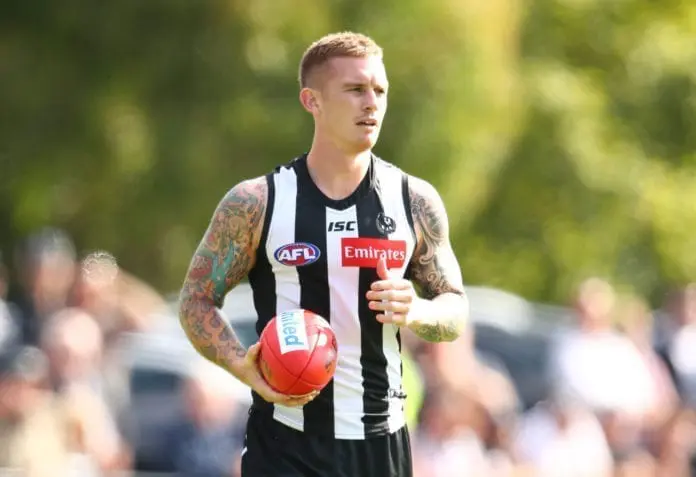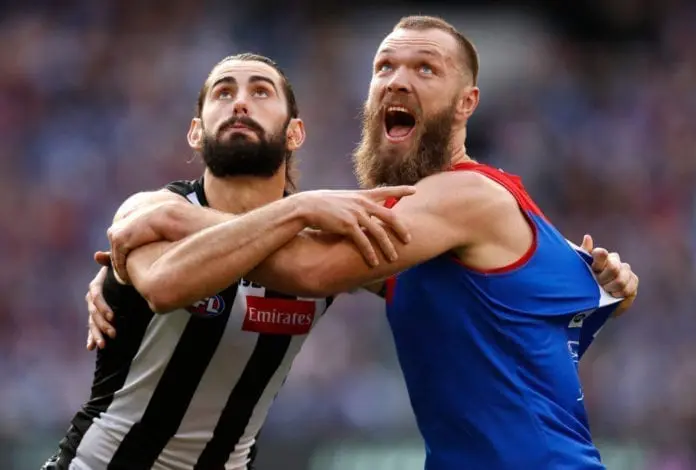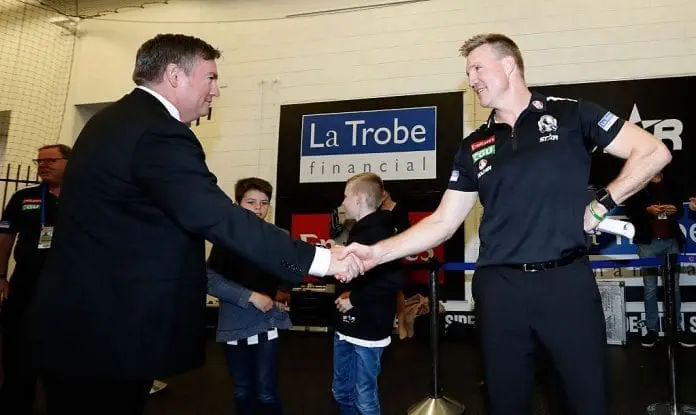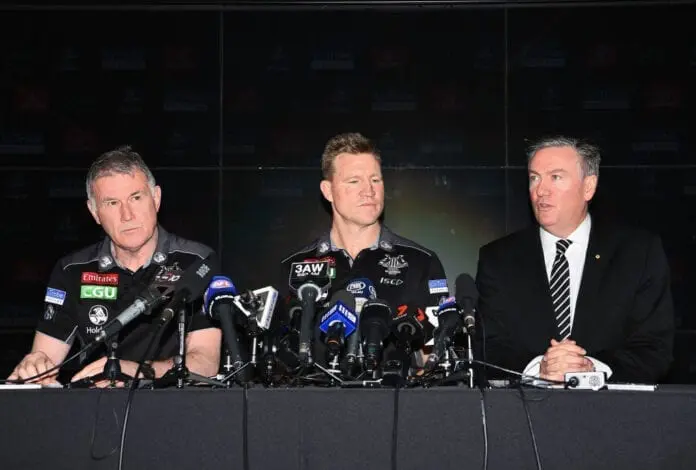The Collingwood Football Club has heralded their seventh annual members forum, to be held on the 14th of December.
The club proclaims they will step supporters through their “strategy”, and shed light on their “short and medium term ambitions”.
Now maybe it’s the cynic in me, but will the debrief be that they wanted to go to the draft to replenish their list, that they couldn’t get market value for outgoing players due to a lack of leverage, but they have a good young list and are looking at a quick turnaround to get right back into contention?
And, hallelujah, let’s agree everything is well at Collingwood?
Even when it isn’t?
The Forum will be virtual, due to COVID-19. Fair enough. But the supporters I talk to are all of the same opinion that questions will be Dorothy Dixers.
For those who don’t know what this means, here’s the Wikipedia definition:
“In Australian politics, a Dorothy Dixer is a rehearsed or planted question asked of a government Minister by a backbencher of their own political party during Parliamentary Question Time.”
This cannot be an exercise in futility.
It mustn’t be.
Somebody told me to let this go. The problem here is this is not just about one thing. That one thing (the trade period) is just the cherry on top of a black and white sundae reeking of sour dairy.
To let this go is to accept poor governance.
To let this go is to excuse poor decisions.
To let this go is to celebrate mistakes.
Let this go?
So … what? Next time anything happens, we all scratch our heads and profess we don’t know how [INSERT ISSUE] could’ve happened? But it’s okay because we trust it won’t happen again – yet again?
In any form of life, the only way you learn, the only way an organisation can improve, is when the individual or group is held accountable.
Then they either get better, or get better people involved.
And if they don’t, they get left behind.
This is why it’s not as simple a case as “let it go”.
There are genuine issues here that need to be addressed.
While the focus is obviously going to be on Collingwood’s 2020 trade period, other questions have also accumulated.
Also, some of those questions from the past have a direct bearing on how and why things are happening now, or why the things happening now can’t be considered outliers.
It would be easy to dismiss me as the lone dissenter. While some have resigned themselves following the trade period, others are still angry and restless. Take a look at the message forums. Take a look at social media.
This is the biggest groundswell of dissatisfaction I’ve seen and experienced at Collingwood in many, many years – in decades.
So instead of glibly trying to skirt past the problems, instead of expecting a cult-like acceptance that there’s nothing to see here, let’s pull it all out into the light for thorough examination, demand some accountability, and from there work out the best way to move forward.
If supporters still want to bury their heads in the sand, or profess that everything’s going swimmingly, that’s fine. That’s your prerogative.
But for the rest of us, let’s LEARN.
I had a list of these queries over two months ago. They were general questions about the state of how Collingwood was faring. Now, following the trade period, they’ve grown and exploded into a much-more comprehensive and searching collection.
I want to make these questions public – to permeate the public consciousness, so either supporters take these questions with them and inundate Collingwood; the club learns of their existence and addresses them; and/or these questions become ingrained as the standard and a failure to answer them implies they’re being avoided.
1. The Salary Cap
Collingwood missed finals 2014–17. They had a whole swath of premiership players depart. The incoming players of note were Daniel Wells, Chris Mayne, Taylor Adams, Brodie Grundy, and Jeremy Howe. The only notable draftees were Grundy, Jordan De Goey and Brayden Maynard.
With the lack of success and quantity of outgoing players during this period, how is it the salary cap became so tight?
In the last two years, Collingwood have traded, delisted, or retired (among others) James Aish, Adam Treloar, Tom Phillips, Jaidyn Stephenson, Ben Reid, Travis Varcoe, Tom Langdon and Dayne Beams.

It’s astonishing so may names have now exited, and queries remain.
While we are still paying part of Adam Treloar’s salary, are we still also paying part of Tom Phillips’, Jaidyn Stephenson’, Dayne Beams’ and Tom Langdon’s? If so, how much? And for how long?
Is there anybody else we’re still paying?
The counter might be every club flirts with paying the full salary cap. Fine. But just recently, the AFL advised clubs to cope with salary cap cuts by back-ending contracts. The clubs responded angrily.
Michael Gleeson wrote a piece about this in The Age, where one list manager – who wanted to remain anonymous – commented, “We will have 18 Collingwoods next year with everyone forced to push the problem down the road. We have worked for years to get our cap under control and keep it under control – as have other clubs – and the AFL advice is to blow it up again.”
Does this not show how atypical this problem is, and how incongruent it is with good management?
What Collingwood did wasn’t a strategy.
It’s folly to normalise it or rationalise it as “hard decisions had to be made”.
The club should’ve never let themselves get into this position in the first place.
It was a bungle.
No other club has gone through a similar purge. Yes, players have left other clubs, but usually to pursue opportunities elsewhere, e.g. Joe Daniher, Orazio Fantasia and Adam Saad all wanted to leave Essendon. Essendon tried to keep them but couldn’t.
At Collingwood, these players wanted to stay. Collingwood drove them out due to the bulging salary cap.
The Magpies now sit as a cautionary tale.
That, in itself, is damning.
2. Back-Ending
Have we retained players simply because we back-ended contracts, and thus became financially obligated to them?
Here’s a simpler way of putting it: are there players who, on performance, we would’ve cut, but we couldn’t because we’d back-ended and back-ended until they became entrenched within the salary cap, and thus had to remain on the list?
If so, this directly impacts Collingwood’s ability to re-sign and pursue talent because they’re obligated to contracts, rather than to players.
3. Graeme Allan
Collingwood had a proven football manager in Neil Balme. Who made the decision to appoint Graeme Allan in 2017? Was it a committee decision? Or was it a captain’s call? Balme then left the club – with good reason too given Allan’s recruitment squeezed Balme out of his own position.
Is it true Allan was appointed with the mandate to get Collingwood in the finals “no matter what” to mollify supporter unrest at that time?
Who gave him such power to make grandiose free agent acquisitions? Were they even done in accordance with the senior coach? Buckley’s response to Chris Mayne in that first season would suggest not.
In the case of Wells, who’d be 32 when the new season started, did Collingwood truly believe that he could play another three years given his injury profile? As it is, just how many 35-year-olds are running around in the AFL?
Why were the club not more judicious in their decision-making?
Or did desperation overrule good sense?
Is desperation the best way to run a club?
4. Dayne Beams
By Nathan Buckley’s admission, Collingwood’s salary cap was tight. This did not just occur overnight. It would’ve been building, and it definitely would’ve been evident as little as two years ago.
Who then decided squeezing in Dayne Beams was a good idea?
Was this the football department’s decision? Or was it a captain’s call? Or was it a politicised decision, i.e. the return of the prodigal son, to prove the cultural growth at Collingwood, and that a player who’d allegedly left (in part) due to his relationship with coach Nathan Buckley was willing to play under him again?
Did the club perform due diligence on Beams? This would seem unlikely given all the red flags that would come up in just the next six months.

Given Collingwood had all the leverage in this deal, why did they surrender so much? Did they consider hard-balling Brisbane?
Compare the way the Bulldogs dealt with Collingwood in regards to Adam Treloar, North Melbourne with Collingwood in relation to Jaidyn Stephenson, and Hawthorn in securing Tom Phillips, with how Brisbane handled Dayne Beams’ exit.
Good on Brisbane, the Bulldogs, North Melbourne and Hawthorn in getting the best value possible for their clubs.
5. The Trade Exodus
If we accept back-ending as a methodology to keep a list together, why did we not trade out players earlier — particularly following the 2018 Grand Final when their value would’ve been at their highest?
Why did we not trade out when we had command of the situation?
Why did senior figures (Ned Guy, Geoff Walsh, Mark Anderson, Nathan Buckley and Eddie McGuire) all sell different stories as to the motivation of what was happening in the trade period?
Buckley unequivocally admitted that the salary cap was an issue. Both Guy and Walsh insisted the salary cap wasn’t an issue.
While I’m sure all this could be massaged into the claim it might’ve been a little bit of everything so everybody was telling the truth, the reality appears that some of these people outright lied to us.
I’m surprised this isn’t a bigger issue.
6. The 2020 Trade Period
It truly seems that when Kim Ravaillion signed with the Queensland Firebirds, Collingwood saw an opportunity to convince hubby Adam Treloar to go to Queensland. The Gold Coast Suns were the only likely destination, given Brisbane were focused on Joe Daniher. The Suns had a juicy pick 5 in the offing. Treloar didn’t want to go.
How much of the narrative surrounding the Treloar deal – from the “hard to coach” comment, concerns about his ability to perform at an elite standard in 2021, and the leadership group wanting him out – truly came from Collingwood?
If Collingwood are/were truly concerned about Treloar’s mental health in 2021 with his wife interstate, did they just dump the problem onto the Bulldogs? How is this synonymous with a club being conscious about player welfare? Doesn’t it actually recontextualise Collingwood’s earlier claim (fearing Treloar could not perform at his best while his wife was in Queensland) as hypocritical?
Was there ever a possibility that we would not go ahead with any of these 2020 trades and retain these players? The truth is it seems they were always destined to go, so opposition clubs just waited until the deadline, and then forced Collingwood to take scraps.
Examining the transactions, Collingwood traded Stephenson, Atu Bosenavulagi and pick 39 for picks 26, Pick 33, and a future fourth-rounder.
Collingwood then traded Adam Treloar, 26, 33 and 42, for pick 14 and future second-round selection.
Effectively, they traded Treloar, Stephenson, Bosenavulagi, Pick 39, and Pick 42, for pick 14 and a future second-rounder – five selections for one low first rounder, and (given the Bulldogs are expected to play finals) a low second rounder.
I’m unsure how anybody justifies that as good trading.

Mason Cox renegotiated his contract. Was this put as an option to the outgoing players? Or even to the club as a whole?
7. Contract Management
Given the mess the salary cap management has been, how can we have confidence in the incumbents to manage it successfully in the future?
With all the shuffling and juggling going on, are we entirely sure we’re clear of any salary cap breaches?
Do we map out the salary cap over a prolonged period, so we know roughly the way it should look year after year for a period of – for example – five years?
Do we take into account what we believe re-signings will cost, who might get a sudden bump, etc.?
Or are we just winging it?
8. Jaidyn Stephenson
Stephenson won the Rising Star in 2018. His statistical return in 2019 is better than his debut year. Granted, he did something stupid with his gambling indiscretion – but lots of young players are guilty of stupid acts.
In 2020, he had glandular fever and struggled to navigate the compromised season and hub-life.
Why was he suddenly considered expendable?

We have seen other players be wayward in their early years, and then blossom into champions, e.g. Dane Swan.
If Stephenson caused off-field issues as is rumoured, how severe were these that the club concluded he was not only irredeemable, but grossly depreciable in terms of trading out?
Isn’t it the club’s responsibility to cultivate and redeem Stephenson given their investment in him? Did they not consider that a normal season might help ground him and refocus him?
Or is the truth that the coaching staff could not find a way to connect to Stephenson, and thus out he went?
9. Height
This club has relied on Moneyball options for key positions — Mason Cox, Brodie Mihocek, Lynden Dunn, Jordan Roughead, etc.
Why have we not invested in genuine height outside a handful of picks?
Or why have we not targeted height in trading, e.g. focusing on Steven May instead of Dayne Beams?
10. Indigenous Players
Why does Collingwood have such a poor record recruiting Indigenous players?
11. Heritier Lumumba
How is Collingwood dealing with Heritier Lumumba?
12. Gameplan
In 2018, we played daring, exciting football. Between 2019–2020, it seems we employed the stodgy, unadventurous, vulnerable gameplan from 2014–17.
At the very least, we’re seeing the same quirks – poor decision-making, skill errors, devolving ball movement, easy opposition goals on the counter-attack, etc.
Either we’re foolishly trying to still make this particular gameplan work, despite the overwhelming evidence it’s unsustainable, or this isn’t the way we want to play, which means the coaches are unsuccessful in communicating the way they do want to play.
Which is the case?
Also, is it true that after implementing a direct and quick approach in their thrilling upset win against the Eagles in the Elimination Final, that Collingwood decided to revert to the short, chipping, indirect gameplan for the Semi Final against Geelong?
If so, is it true senior members at Collingwood had robust disagreements about it which disheartened the playing group and led to the insipid effort (or lack thereof) in that final?
13. Ruck–Midfield Relationship
The lack of rapport between ruck and midfield was an issue as far back as the 2018 Grand Final. It remained a constant throughout 2019. It was then highlighted in the 2019 Preliminary Final. And it remains an issue to this day.

When will this be successfully addressed? Surely it shouldn’t take three years to work out midfield synergy. Who is responsible for this department?
14. Coaches
Given our lack of success with this coaching panel, why have we not made changes? E.g. why have we not pursued somebody like Luke Hodge or Sam Mitchell as assistants?
With no disrespect intended to Robert Harvey and Brenton Sanderson, shouldn’t we get an injection of fresh ideas coming through the place?
Why do we not recruit a specialist ruck coach for Brodie Grundy, Mason Cox, Darcy Cameron and Max Lynch, instead of using a player who was a pinch-hit ruckman in Anthony Rocca?
Why have we appointed a midfielder (Harvey) to be the defensive line coach? We saw how dramatically we improved in the one year (2018) when we had an injection of fresh ideas.
If Collingwood struggle next year, would we be looking at wholesale changes? Or will Buckley be backed in to oversee another rebuild?
What’s a pass mark? Is there a fail mark?
15. The Presidency
Eddie McGuire was voted into power at the end of 1998. He was brilliant in guiding Collingwood back to respectability, and overseeing their growth into a Victorian powerhouse. But everybody has their time, and several issues have marred the second half of his tenure.
Is one of the motivations behind his longevity to become the longest-serving Collingwood president, which would mean he overtakes Harry Curtis (twenty-six years: 1924–1950)?
(As an aside, it should be highlighted that Collingwood won 6 flags in the first twelve years of Curtis’s reign, and zero in the next fourteen years. They played in the finals on only four occasions from 1940–1950, and appeared in no grand finals.)

Does McGuire have any plan to relinquish power? Or does he intend to rule until they pry Collingwood from his cold, dead hand?
We have seen some unpardonable gaffes, e.g. what he said about Adam Goodes, Caroline Wilson and Cynthia Banham. Any other employee in any other industry would’ve been immediately terminated. We have afforded him considerable leeway.
This year, McGuire passionately demanded that the next player to commit a COV-19 related breach should be punished stringently.
That next player was Collingwood’s vice-captain, Steele Sidebottom.
Not long after, McGuire then double-downed with another rant.
His senior coach (Buckley) and senior assistant (Sanderson) then committed the next indiscretion.
While McGuire should be commended for insisting on high standards of governance within the AFL given the seriousness and threat of COVID-19, does he not realise how public declamations impact Collingwood?
Also, is it true that following Sidebottom’s suspension, senior figures at Collingwood had strong words about the suspension’s length, and felt that McGuire’s COVID-rant had backed them into a place they could not appeal the length of the suspension?
Allegedly, in the early 1990s when then-president Allan McAlister made a series of gaffes, the committee gagged him.
Have the committee had similar concerns with McGuire?
Even Caroline Wilson pointed out on Footy Classified that McGuire’s episodes affect Collingwood. Rather than address this seriously or constructively, McGuire jokingly walked off set.
Can McGuire himself not see how disruptive all this is?
16. The Presidency and the Board
As far as the president and the board go, why do we not have fixed terms, so that there’s always new ideas and new hunger coming through?
17. The Football Manager / Geoff Walsh
Did Geoff Walsh retire? Or was he the sacrifice – an attempt to appease the masses following the debacle of the trade period?

18. Only the Best
We are a club whose motto is “Only the Best”.
But in which departments can we truly boast that we have the best personnel? It seems a lot of appointments come internally. Are we that fortunate that we have the best personnel readily available at all times? If they are the best, why didn’t they have those jobs in the first place?
Given we’re a wealthy club, why don’t we simply pay the tax that comes from exceeding the soft cap and appoint whoever we need to find whatever advantage we can?
Fitness, medical and – now – list management/trading are three areas that have question marks.
If we want to be the best, shouldn’t the best take care of our most precious assets?
19. The Plan
Brendan Gale famously set down Richmond’s plan years ago. Other clubs have similar (but less publicised) blueprints.
We seem to improvise and adapt. Certainly, a fire sale couldn’t have been in any of our planning.
While we profess a short- and medium-term plan, what is it?
What is our blueprint moving forward?
What is our expectation for 2021?
Where does Collingwood foresee itself by 2025 and 2030?
20. Social Media
Why are the club’s social media messages so tonally incongruous to the current landscape?
For example, deep into the trade period, the club changed their Facebook banner to a picture of Scott Pendlebury (AFL captain), Steph Chiocci (AFLW captain) and Geva Mentor (Collingwood netball captain), with the slogan “Made by Many”.
It’s an odd message to be selling while driving players out. Supporters responded with unsurprising vitriol. This should’ve shown the club what a foul-up this was.
But, on the final day of the trade period, the Twitter account asked supporters what they expected from the day – just hours before Collingwood exited four players.
Again, supporters responded angrily.
Collingwood sent out memorabilia to the members proclaiming, “TOGETHER FOREVER”.
Um, what?
Do you honestly not realise how much this jars with the collective feeling at the time?
21. Members
How many members have cancelled following the trade period?
While some of these cancellations can obviously be attributed to COVID-19, and not knowing what 2021 will look like, does the club read the genuine displeasure that is now rustling through the supporter base?
Will 2021 memberships in any way be discounted given a 2020 membership was effectively just a donation to the club?
While the membership department is now operating with a skeleton staff, I know various members who’ve complained about how they’ve been treated in the past.
They feel the membership department is prompt and eager when they want money, but hard to contact or get an answer from if it’s another query.
Conclusion
While there’ll always be on and off-field issues in football, does the club understand how shaken Collingwood supporters are?
This is not just about one player.
And it’s not just about one block of time (the trade period).
This has built over the last decade.
In 2017, many of the supporters were disillusioned with how Collingwood were moving forward, and had found the previous five years – repeatedly missing finals, constant injuries, list management queries, off-field indiscretions, etc. – disenfranchising.
The grand final appearance in 2018 was a bandage over all this, but 2019 ripped that bandage off, and 2020 rubbed salt into the wound.
Some supporters have “gotten over it”, or resigned themselves, but they haven’t really, because they expect the club to emerge constructively and positively, but because they know nothing will really change and there’s no point arguing.
Others are still dissatisfied.
Outside of blind patriotism and the typical calls for unity, given everything that’s happened, why should we have confidence in the incumbents moving forward?
In the last decade, these questionable decisions have occurred over and over and over.
The genuine tragedy isn’t that they’ve happened.
But that they could again.
























